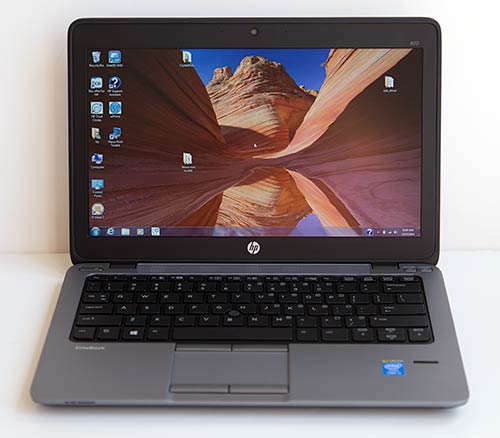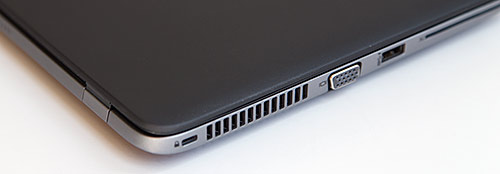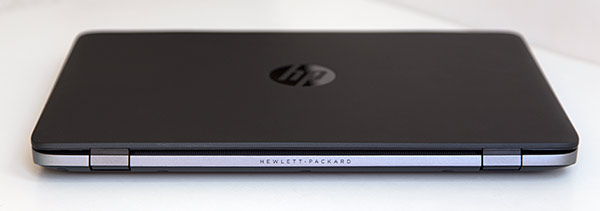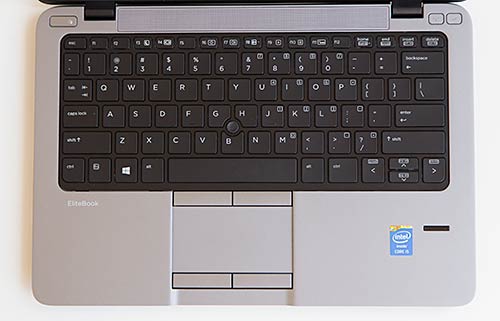HP EliteBook 820 G1
12:18
Business Ultrabooks don't have to be homely. In
fact, they don't even have to run Windows 8, if Windows 7 is your
company's cup of tea. The HP EliteBook 820 is a good looking Ultrabook
that shares a hint of design DNA with HP's attractive consumer
Ultrabooks like the Spectre 13. Unlike consumer models, the EliteBook is
extremely easy to upgrade--heck it's designed to be opened up for
upgrades. No need to fiddle with obscure tiny screws or adhesive strips.
It also has more ports than you'll find on the average consumer 12.5"
to 13.3" Ultrabook. Even better, while business machines are often
priced much higher than consumer models, a decently equipped 820 costs
just $874. So what's the catch? Like many business laptops, the screen
lacks the boldness and clarity of consumer models, and there's no touch
screen on most models (HP does list it as a build to order option). We
get the feeling that HP aims the 820 at Windows 7 users, so the lack of a
touch screen isn't the end of the world, but we'd love to see better
looking displays on business laptops. Since this is a business model, HP
includes security features like HP Trust Circles that will only allow
assigned contacts access to files on your PC and HP SureStart, which
offers BIOS protection and healing. The laptop also has a fingerprint
scanner and TPM.

Design and Ergonomics
The EliteBook 820 is a surprisingly
attractive Ultrabook with a tapered design, contrasting lid and side
colors and a magnesium casing. The laptop passed a number of MIL-STD
810G tests for things like dust, drops and vibrational shock. It feels
solid and it should appeal to those who feel that ThinkPads are dull
matte black blocks.

Perhaps the most enchanting thing in a
sea of similarly spec'd and sealed Ultrabooks is the removable bottom
panel. This grants easy access to all internals including the battery,
socketed WiFi + Bluetooth card, 2.5" SATA HDD/SSD drive bay, a flash
cache slot (optional for HDDs to speed them up) and a WAN card slot. HP
offers 3G HSPA+ and 4G LTE broadband cards for $109 and $229
respectively. Even better, there are two RAM slots (most 13.3" and
smaller Ultrabook RAM is soldered on board and is thus not upgradable).
For do it yourself types and IT departments, this sort of easy repair
and upgradeability is rarer than platinum and every bit as valuable.
Note that the CPU is still soldered on board, as is the case for most
all laptops except some big gaming rigs.

The HP has ample ports by 12.5" laptop
standards. It has a VGA port (still popular in business settings where
old equipment like VGA projectors hang around forever), a DisplayPort
for driving modern, greater than full HD monitors, three USB 3.0 ports
(two on the right and one on the left with charging), Ethernet RJ-45, a
smart card reader, docking port, SD card slot and a 3.5mm combo
headphone-mic jack. The laptop has dedicated buttons for wireless and
audio mute above the keyboard
Display
This isn't the happy part of our review.
The display is somewhat washed out and murky compared to today's sharp
and clear consumer oriented panels on similarly priced laptops. When you
get close to $1,000, we expect lots of clarity and a wide color
gamut... something that the Acer Aspire S7 (both generations), HP Spectre 13, Sony Vaio Flip 13 and Flip 13, Dell XPS 12 (often selling for $799 or less) and the Lenovo ThinkPad Yoga
and Yoga 2 13" give us. Granted the EliteBook is about $100 cheaper
than the $1,000 average for Ultrabooks with great screens, but we do
wish that HP offered a good upgrade option. The display resolution is
1366 x 768, and while that might sound low to those accustomed to 1080p
Ultrabook screens, for a business laptop I have no complaints: text,
graphics and icons are all readable without display scaling and at
12.5", the resolution is perfectly adequate. Viewing angles are limited,
but business users might count that as a plus given the privacy it
offers, and we love that this is a matte display.
Keyboard and Trackpad
HP makes a good keyboard, though not as
good as Lenovo ThinkPads and Dell XPS models in terms of tactile feel.
Still, it's more tactile than the Spectre 13 and Sony Vaio laptops, to
name a few. This is a standard keyboard with a normal layout and for
those who are defecting from ThinkPad land, there's a TrackPoint style
eraser stick pointer embedded in the keyboard. The keyboard is water
resistant with drain holes and it has very even backlighting. The
trackpad is pleasant and predictable and it has mechanical buttons top
(for the pointing stick) and bottom (for the trackpad). Those of you who
hate the now more common buttonless trackpads will no doubt enjoy HP's
more "traditional" trackpad design. We like that the buttons don't
require lots of force, as do some buttonless trackpad underlying click
mechanisms.
Performance and Horsepower
The EliteBook 820 is a standard
Ultrabook that runs on Intel 4th generation Haswell ULV Ultrabooks CPUs.
It's available with the 1.7GHz Core i3-4010U, 1.6GHz Core i5-4200U,
2.9GHz Core i5-4300U and 2.1GHz Core i7-4600U CPUs, all with Intel HD
4400 integrated graphics. There are two standard SODIMM RAM slots
(1600mhz DDR3 RAM required) and you can order it with 4, 8 or 16 gigs
of RAM. Note that if you order it with Windows 7 32 bit, you can only
order 4 gigs of RAM since 32 bit operating systems can't address more
memory. Go with Windows 7 64 bit or Windows 8 64 bit if you intend to
install more than 4 gigs of RAM.
Storage options are unusually
versatile with the EliteBook 820. The laptop is available with
conventional spinning 2.5" SATA HDDs in varying capacities (both 5400
and 7200 RPM drives are available) and a 32 gig caching drive is
optional. Alternatively you can order it with an SSD drive (again in a
variety of capacities), or get a 120 gig M.2 solid-state drive plus an
HDD. The laptop has both a 2.5" SATA drive bay and an M.2 slot for a
caching drive or M.2 SSD.
Performance on our fairly middle
of the road Core i5-4200U with 4 gigs of RAM and a 180 gig SSD was par
for the course among current generation Ultrabooks with Intel HD 4400
graphics. Honestly, there's little difference among Intel Haswell 4th
generation Ultrabooks equipped with a Core i5 and SSD. You're buying the
design, display, ports and features rather than a performance edge.
HP's software load on business machines is minimal, so the EliteBook
isn't plagued by bloatware that might slow it down. Likewise, it's a
fairly cool and quiet machine. You'll hear the fan ramp up when plugged
in and doing demanding tasks like HD video export, but otherwise it's
fairly quiet.
Battery Life
Yes! The EliteBook 820 has a
removable battery, another rarity on an Ultrabook. Our review unit has
the larger 46 Wh battery, and it averaged 7 to 7.5 hours on a charge
with average use and brightness set to 50%. We tested in a mix of tasks
including email, web browsing, working in MS Office, social networking
and streaming a 45 minute episode of House of Cards via Netflix. That's
average among Ultrabooks where the MacBook Air lasts the longest at 12
hours and the Sony Vaio Pro and Acer Aspire S7 manage 6.5 hours.



0 comments